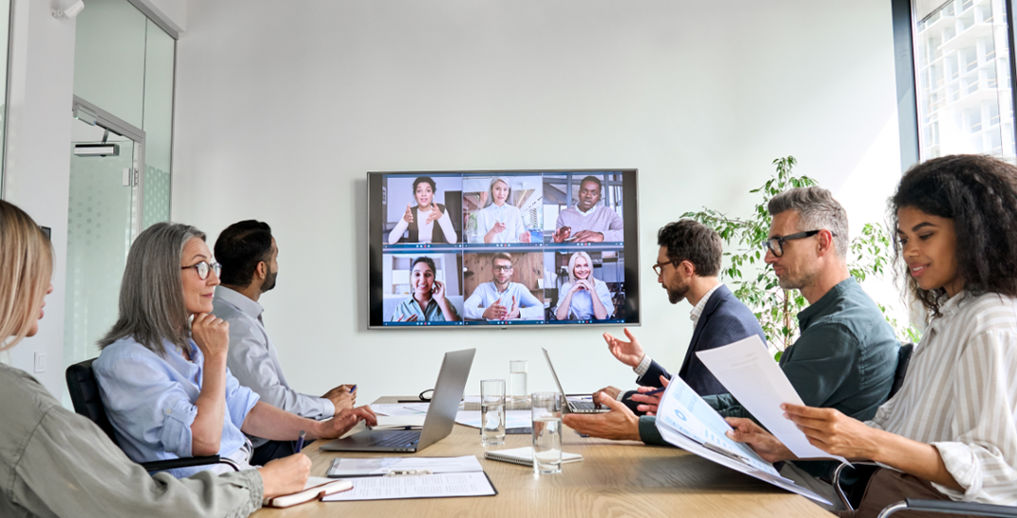The Rise of Touchless Technology
If the last two years have taught us anything, how users work and how organizations communicate have changed. While Digital Signage usage continues to increase across corporations, retail spaces, universities, and K-12 schools, the vehicles and use of the signage have adjusted to include tablets, mobile devices, and touchless technology.
QR Codes, Gesture, Control and Voice Control Impact Touchless Technology
Think about it— just two short years ago, you’d walk into a restaurant, and the host would hand you a physical menu. You’d flip through the menu, sometimes sticky from the leftover cleaning solution residue or speckled with tidbits of old ketchup and decide what to order. Some restaurants were utilizing interactive kiosks, where you flip through menus on a screen, choose what you want, and take the receipt up to the counter to pay.
Since the pandemic, restaurants have ditched the physical menu, cut down on the interactive kiosks, and switched to a QR code that’s presented on a Digital Signage display or plaque. The customer scans the QR code, and the menu pops up on their mobile device.
The same rings true across corporate spaces and how they communicate and interact with users. While interactivity continues to be important, doing so has adjusted to meet the current world environment. An increase in gesture control, voice control, and facial recognition can drive the interactivity of digital signage, alleviating the need to touch the screen.
Many of us are already using voice control in our daily lives. Whether it’s opening up an app on our phone, doing a web browser search, or activating a Smart Home routine via a Smart Speaker, Voice Control is engrained in how we operate in our daily lives, making it an ideal interactive solution for Digital Signage. With Voice Control, a user can walk up to the display and search a directory, place a food order, or access wayfinding, all with their voice.
There’s gesture control for those looking for a solution that has the feel of touch but still removes the actual physical touch of the screen. With Gesture Control, a user can flip through a directory or access various applications on a Digital Signage display. All by waving their hands in specific directions, all without touching the display.
Additionally, as mentioned above, QR codes are becoming another means of extending Digital Signage from the static display to the mobile device.
One place where we have seen this is in the lobby space. Often, Digital Signage has been implemented as an interactive kiosk allowing a visitor to “check in,” letting the person they are visiting know they are in the lobby waiting for them. This experience can be a manual process where the user needs to enter all their information via a touchscreen, and it gets submitted. Then an email alert goes to the company contact. With QR code integration, the options for visitor check-in become endless. The QR code can be placed on the Digital Signage display, which the visitor then scans. This visitor can either fill out the form on their mobile device, alleviating any need to touch the screen, or the code can be coded to access a live Virtual Receptionist. The virtual receptionist can check the visitor in via video, removing any need for filling out a form.
These are all aspects of Digital Signage that existed before the pandemic but have seen heavier demand because of how the pandemic changed the way we work.
Digital Signage for Analytics
Digital Signage usage continues to thrive in warehouses and R&D facilities needing to display real-time analytics while decreasing the need to rely on paper printouts. Now that most analytics can be provided via cloud-based software, Digital Signage can be used to communicate necessary data to the field staff.
Many of today’s Digital Signage solutions can integrate with analytics platforms, allowing a display to showcase pertinent data and the corporate messaging all from one dashboard.
Conference Room Signage
With Return to Work initiatives in full effect, organizations are looking for ways to utilize their conference room technology. Similar to hotel rooms, where you walk into the room and are greeted with a message welcoming you to the hotel and providing pertinent hotel information, conference room displays are being turned into Digital Signage solutions. These solutions offer corporate messaging and calendar information when the room is not in use for presentations or conferencing. This allows organizations to utilize their existing technology in new ways while ensuring their workforce continues to receive the necessary messaging.
Video Walls
This does not mean that organizations are doing away with large-scale video walls. There continues to be a demand for these as it is a way to take corporate messaging and turn it into a showcase piece. Integrators are teaming up with graphic designers to turn Digital Signage on its head, adding levels of graphics and video that one is used to seeing at high-end retail stores, stadiums, and the Las Vegas Strip.
These types of Digital Signage provoke conversation among visitors and the staff. It elevates the messaging to one that is memorable and keeps everyone engaged. With these times where organizations are finding ways to keep employees engaged, this is just one small way of making that happen.
Make sure to visit New Era’s Wayfinding Project to see via video how a digital signage solution now helps direct travelers to the right concourse at the Indianapolis International Airport. Contact New Era today to learn more at solutions@neweratech.com.

 Canada
Canada Australia
Australia New Zealand
New Zealand UAE
UAE United Kingdom
United Kingdom





